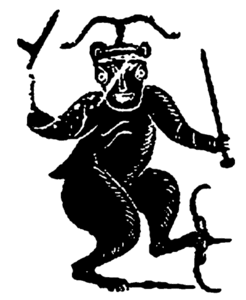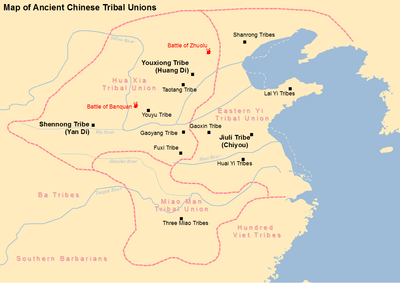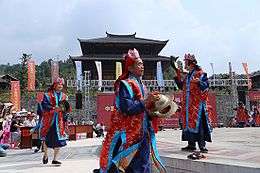Chiyou
Chiyou (蚩尤) was a tribal leader of the Nine Li tribe (九黎) in ancient China.[1] He is best known as a king who lost against the future Yellow Emperor during the Three Sovereigns and Five Emperors era in Chinese mythology.[1][2][3] For the Hmong people, Chiyou[4] was a sagacious mythical king.[5] He has a particularly complex and controversial ancestry, as he may fall under Dongyi[1] Miao[5] or even Man,[5] depending on the source and view. Today, Chiyou is honored and worshipped as the God of War and one of the three legendary founding fathers of China.
| Chiyou | |||||||||
|---|---|---|---|---|---|---|---|---|---|
 Chi You as depicted on a tomb relief of the Han dynasty (206 BCE – 220 CE) | |||||||||
| Chinese name | |||||||||
| Traditional Chinese | 蚩尤 | ||||||||
| Simplified Chinese | 蚩尤 | ||||||||
| |||||||||
| Vietnamese name | |||||||||
| Vietnamese | Xi Vưu | ||||||||
| Korean name | |||||||||
| Hangul | 치우 | ||||||||
| Hanja | 蚩尤 | ||||||||
| |||||||||
| Japanese name | |||||||||
| Kanji | 蚩尤 | ||||||||
| Hiragana | しゆう | ||||||||
| |||||||||
Description
Individual
According to the Song dynasty history book Lushi, Chiyou's surname was Jiang (姜), and he was a descendant of Yandi.[6]
According to legend, Chiyou had a bronze head with a metal forehead.[1] He had 4 eyes and 6 arms, wielding terrible sharp weapons in every hand.[7] In some sources, Chiyou had certain features associated with various mythological bovines: his head was that of a bull with two horns, although the body was that of a human, and his hindquarters were those of a bear.[7] He is said to have been unbelievably fierce, and to have had 81 brothers.[7] Historical sources often described him as 'bold leader',[6] as well as 'brave'.[8] Some sources have asserted that the figure 81 should rather be associated with 81 clans in his kingdom.[5] Chiyou knows the constellations and the ancients spells for calling upon the weather. For example, he called upon a fog to surround Huangdi and his soldiers during the Battle of Zhuolu.
Tribe
Chiyou (Txiv Yawg) is regarded as a leader of the Nine Li tribe (九黎, RPA White Hmong: Cuaj Li Ntuj) by nearly all sources.[1] However, his exact ethnic affiliations are quite complex, with multiple sources reporting him as belonging to various tribes, in addition to a number of diverse peoples supposed to have directly descended from him.
Some sources from later dynasties, such as the Guoyu book, considered Chiyou's Li tribe to be related to the ancient San miao tribe (三苗).[9] In the ancient Zhuolu Town is a statue of Chiyou commemorating him as the original ancestor of the Hmong people.[10] The place is regarded as the birthplace of the San miao / Miao people,[10] the Hmong being a subgroup of the Miao. In sources following the Hmong view, the "nine Li" tribe is called the "Jiuli" kingdom,[5] Jiuli meaning "nine Li". Modern Han Chinese scholar Weng Dujian considers Jiuli and San Miao to be Man southerners.[11] Chiyou has also been counted as part of the Dongyi.[1]
Epic battles

When the Yan emperor was leading his tribe and conflicts with Nine Li tribes led by Chiyou,[1] the Yan emperor stood no chance and lost the fight. He escaped, and later ended up in Zhuolu begging for help from the Yellow Emperor.[1] At this point the epic battle between Chiyou and the Yellow Emperor's forces began. The battle last for 10 years with Chiyou having the upper hand. During the Battle of Zhuolu, Chiyou breathed out a thick fog and obscured the sunlight.[12] The battle dragged on for days while the emperor's side was in danger.[7] Only after the Yellow Emperor invented the south-pointing chariot, did he find his way out of the battlefield.[7][12] Chiyou then conjured up a heavy storm. The Yellow Emperor then called upon the drought demon Nüba (女魃), who blew away the storm clouds and cleared the battlefield.[12] Chiyou and his army could not hold up, and were later killed by the Yellow Emperor.[1][7] After this defeat, the Yellow Emperor is said to become the ancestor of all Huaxia.[7] The Hmong were forced to live in the mountains and leave their Li kingdom.[10] After Chiyou's death, it is said that it rained blood for some time.
Societal influence

According to the Records of the Grand Historian, Qin Shi Huang worshiped Chiyou as the God of War, and Liu Bang worshiped at Chiyou's shrine before his decisive battle against Xiang Yu. The mythical title God of War was given to Chiyou because the Yellow Emperor and Yan Emperor could not defeat Chiyou alone. Altogether, Chiyou won 9 major battles including 80 minor confrontations. On the 10th and final war, both emperors combined their forces and conquered Chiyou.
Chiyou remains as a figure of worship today.
In one mythical episode, after Chiyou had claimed he could not be conquered,[2] the goddess Nuwa dropped a stone tablet on him from Mount Tai. Chiyou failed to crush the stone, but still managed to escape. From then on, the 5-finger-shaped stone tablet, inscribed "Mount Tai shigandang" (泰山石敢當) became a spiritual weapon to ward off evil and disasters.[2][13]
According to notes by the Qing Dynasty painter Luo Ping: "Yellow Emperor ordered his men to have Chiyou beheaded... seeing that Chiyou's head was separated from his body, later sages had his image engraved on sacrificial vessels as a warning to those that would covet power and wealth."[14]
The Tale of Heike mentions a comet "of the type called Chiyou's Banner or Red Breath."[15]
In popular culture
- Ch'ih-yu (conceptualized as a dragon) is one of the characters in the background story in The Settlers III.
- Chi You is a name for an Aragami creature in the PlayStation Portable game, God Eater.
- Chiwoo, also called "Chiwoo Cheonwang" (치우천왕, Hanja 蚩尤天王, meaning 'Chiyou, King of Heaven') in Korea, is the mascot of the Red Devils, the supporters' group of the South Korean national football team.
- South Korea's official bullion coin, the Chiwoo Cheonwang, is named after Chiyou and features him on the coin's obverse.
- The comic book Heavenly Executioner Chiwoo is partly based on the legends about Chiyou.
- The main antagonist of the Shenmue saga, Lan Di, is one of the leaders of a group called the Chi You Men, who seek to awake the power of the God Chi You.[16]
- Chi You appears as an antagonist in the TMNT/Ghostbusters miniseries of the Teenage Mutant Ninja Turtles IDW comics continuity. Herein he is a godling or immortal creature who is engaged with others of his kind—including the Rat King and Kitsune—in a "game" for dominion over mankind.
- There is a Mechanical Mod used in the vaping community known as the Chi You.
- He is also a reoccurring demon in the Megami Tensei video game series.
- Chi You appears as sub-boss enemy in the video game La-Mulana.
- Chi You's clan became a group of priestess/assassin combo in Kingdom, where Qiang Lei was once part of.
References
- 戴逸, 龔書鐸. [2002] (2003) 中國通史. 史前 夏 商 西周. Intelligence press. ISBN 962-8792-80-6. p 32.
- Lee, James. [2006] (2006). James Lee Astrology guide 2006 English edition. World publishing co. ISBN 962-432-503-0. p 318.
- Greg Woolf (2007). Ancient civilizations: the illustrated guide to belief, mythology, and art. Barnes & Noble. p. 213. ISBN 978-1-4351-0121-0.
- Hmong: Zid Yeus; Xong: Puob Youl; Laotian RPA White Hmong: Txiv Yawg /tsi ʝaɨ/
- Ya Po Cha. [2010] (2010). An Introduction to Hmong Culture. McFarland, 2010. ISBN 0-7864-4951-9, ISBN 978-0-7864-4951-4. pg 8.
- Luo Mi (罗泌). Lushi. 后记四:蚩尤传.
- 王恆偉. (2005) (2006) 中國歷史講堂 #1 遠古至春秋. 中華書局. ISBN 962-8885-24-3. p 11-13.
- 司马, 迁. 史记. 五帝本纪.
- (國語·楚語下)
- De la Cadena, Marisol. Starn, Orin. Wenner-Gren Foundation for Anthropological Research. [2007] (2007). Indigenous experience today. Berg Publishers, 2007. ISBN 978-1-84520-519-5. pg 239.
- Schein, Louisa (2000). Minority rules: the Miao and the feminine in China's cultural politics. Duke University Press. p. 42. ISBN 978-0-8223-2444-7.
- Big5.china.com.cn. "Big5.china.com.cn." 黃帝大戰蚩尤與指南車. Retrieved on 2010-08-22.
- Lee, James. [2006] (2006). James Lee Astrology guide 2006 Chinese edition. World publishing co. ISBN 962-432-502-2. p 208-209.
- Wangheng Chen; Various (2001). Chinese Bronzes: Ferocious Beauty. Asiapac Books Pte Ltd. pp. 62–63. ISBN 978-981-229-020-5.
- The Tales of the Heike. Translated by Burton Watson. Columbia University Press. 2006. p. 38. ISBN 9780231138031.
- "Chi You Men". ShenmueDB. Retrieved 2019-11-17.
Bibliography
- Michael J. Puett, The Ambivalence of Creation: Debates Concerning Innovation and Artifice in Early China. 2001